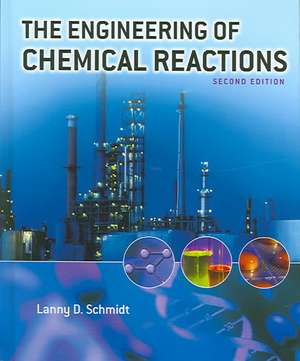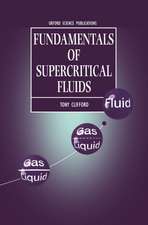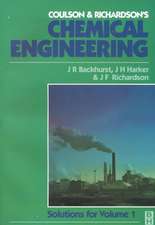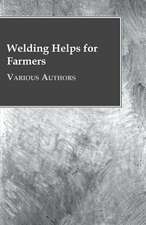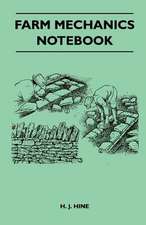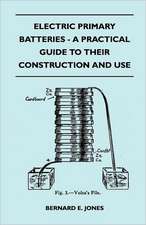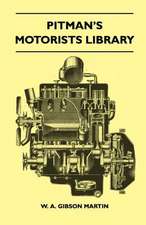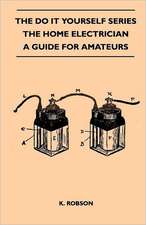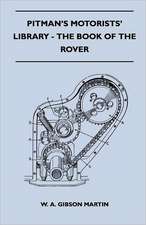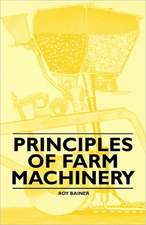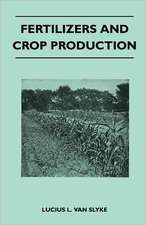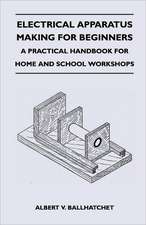The Engineering of Chemical Reactions: Topics in Chemical Engineering
Autor Lanny D. Schmidten Limba Engleză Hardback – 31 iul 2004
Din seria Topics in Chemical Engineering
- 27%
 Preț: 782.24 lei
Preț: 782.24 lei - 47%
 Preț: 424.34 lei
Preț: 424.34 lei - 16%
 Preț: 1473.63 lei
Preț: 1473.63 lei - 30%
 Preț: 1203.46 lei
Preț: 1203.46 lei - 34%
 Preț: 657.54 lei
Preț: 657.54 lei - 17%
 Preț: 1454.43 lei
Preț: 1454.43 lei - 23%
 Preț: 840.80 lei
Preț: 840.80 lei - 33%
 Preț: 647.87 lei
Preț: 647.87 lei - 34%
 Preț: 718.02 lei
Preț: 718.02 lei - 30%
 Preț: 434.56 lei
Preț: 434.56 lei - 30%
 Preț: 689.54 lei
Preț: 689.54 lei - 30%
 Preț: 1450.86 lei
Preț: 1450.86 lei - 29%
 Preț: 850.38 lei
Preț: 850.38 lei - 30%
 Preț: 1405.57 lei
Preț: 1405.57 lei - 5%
 Preț: 1091.19 lei
Preț: 1091.19 lei
Preț: 1492.38 lei
Preț vechi: 2044.35 lei
-27% Nou
Puncte Express: 2239
Preț estimativ în valută:
285.66€ • 310.39$ • 240.11£
285.66€ • 310.39$ • 240.11£
Carte disponibilă
Livrare economică 31 martie-14 aprilie
Preluare comenzi: 021 569.72.76
Specificații
ISBN-13: 9780195169256
ISBN-10: 0195169255
Pagini: 640
Ilustrații: numerous line figures
Dimensiuni: 193 x 234 x 33 mm
Greutate: 1.28 kg
Ediția:Second.
Editura: Oxford University Press
Seria Topics in Chemical Engineering
Locul publicării:New York, United States
ISBN-10: 0195169255
Pagini: 640
Ilustrații: numerous line figures
Dimensiuni: 193 x 234 x 33 mm
Greutate: 1.28 kg
Ediția:Second.
Editura: Oxford University Press
Seria Topics in Chemical Engineering
Locul publicării:New York, United States
Descriere
Thoroughly revised and updated in this second edition, The Engineering of Chemical Reactions focuses explicitly on developing the skills necessary to design a chemical reactor for any application, including chemical production, materials processing, and environmental modeling. This edition also features two new chapters on biological and environmental reaction engineering that provide an exciting introduction to these increasingly important areas of today's chemical engineering market.Streamlined to enhance the logical flow of the subject, The Engineering of Chemical Reactions, 2/e, is easy for instructors to navigate and students to follow. Using real reactions from chemical engineering, the first seven chapters cover such fundamentals as multiple reactions, energy management, and catalytic processes. The final five chapters explore more advanced topics including environmental, polymer, solids processing, biological, and combustion reactions. Practical, real-world examples throughout the text consider reactor and process choices in ways that encourage students to think creatively and build on previous knowledge.The Engineering of Chemical Reactions, 2/e, is ideal for upper-level undergraduate courses in chemical reactor engineering, chemical reactor design, and kinetics.
Cuprins
Each Chapter ends with Problems. Most chapters end with References.Preface to the Second EditionPreface to the First EditionPART I: FUNDAMENTALS1. Introduction1.1. Chemical Reactors1.2. Chemical Reaction Engineering1.3. What Do We Need To Know?1.4. Industrial Processes1.5. Modeling1.6. Sources2. Reaction Rates, The Batch Reactor, and The Real World2.1. Chemical Reactions2.2. Multiple Reactions2.3. Reaction Rates2.4. Approximate Reactions2.5. Rate Coefficients2.6. Elementary Reactions2.7. Stoichiometry2.8. Reaction Rates Near Equilibrium2.9. Reactor Mass Balances2.10. The Batch Reactor2.11. Variable Density2.12. Chemical Reactors2.13. Thermodynamics and Reactors2.14. Adiabatic Reactor Temperature2.15. Chemical Equilibrium2.16. Petroleum Refining2.17. Polyester from Refinery Products and Natural Gas2.18. "What Should I Do When I Don't Have Reaction Rates?"2.19. Reaction-Rate Data2.20. Summary3. Single Reactions in Continuous Isothermal Reactors3.1. Continuous Reactors3.2. The Continuous Stirred Tank Reactor3.3. Conversion in a Constant-Density CSTR3.4. The Plug-Flow Tubular Reactor3.5. Conversion in a Constant-Density PFTR3.6. Comparison Between Batch, CSTR, and PFTR3.7. The 1/r Plot3.8. Semibatch Reactors3.9. Variable-Density Reactors3.10. Space Velocity and Space Time3.11. Chemical Reactors in a Series3.12. Autocatalytic Reactions3.13. Reversible Reactions3.14. Transients in Continuous Reactions3.15. Some Important Single-Reaction Processes: Alkane Activation3.16. Synthesis Gas Reactions3.17. Staged Reactors3.18. The Major Chemical Companies3.19. Reactor Design for a Single Reaction3.20. Notation4. Multiple Reactions in Continuous Reactors4.1. Some Important Industrial Chemical Processes4.2. The Petrochemical Industry4.3. Olefins4.4. Mass Balances4.5. Conversion, Selectivity, and Yield4.6. Complex Reaction Networks4.7. Series Reactions4.8. Parallel Reactions4.9. Multiple Reactions with Variable Density4.10. Real Reaction Systems and Modeling4.11. Approximate Rate Expressions for Multiple-Reaction Systems4.12. Simplified Reactions4.13. Reaction Mechanisms4.14. Collision Theory of Bimolecular Reactions4.15. Activated Complex Theory4.16. Designing Reactors for Multiple Reactions5. Nonisothermal Reactors5.1. Heat Generation and Removal5.2. Energy Balance in a CSTR5.3. Energy Balance in a PFTR5.4. Equations to be Solved5.5. Heat Removal or Addition to Maintain a Reactor Isothermal5.6. Adiabatic Reactors5.7. Trajectories and Phase-Plane Plots5.8. Trajectories of Wall-Cooled Reactors5.9. Exothermic Versus Endothermic Reactions5.10. Other Tubular Reactor Configurations5.11. Temperature Profile in a Packed Bed6. Multiple Steady States and Transients6.1. Heat Generation and Removal in a CSTR6.2. Adiabatic CSTR6.3. Stability of Steady States in a CSTR6.4. Observation of Multiple Steady States6.5. Transients in the CSTR with Multiple Steady States6.6. Other Reactions in a CSTR6.7. Variable Coolant Temperature in a CSTR6.8. Designing Reactors for Energy Management7. Catalytic Reactors and Mass Transfer7.1. Catalytic Reactions7.2. Catalytic Reactors7.3. Surface and Enzyme Reaction Rates7.4. Porous Catalysts7.5. Transport and Reactions7.6. Mass Transfer Coefficients7.7. External Mass Transfer7.8. Pore Diffusion7.9. Temperature Dependence of Catalytic Reaction Rates7.10. The Automotive Catalytic Converter7.11. The Catalytic Wall Reactor7.12. Langmuir-Hinshelwood Kinetics7.13. Summary of Surface Reaction Kinetics7.14. Designing Catalytic Reactors7.15. Electrochemical Reactors7.16. Real Catalytic Reactors7.17. Bioreactors7.18. The Human ReactorPART II: APPLICATIONS8. Nonideal Chemical Reactions8.1. The "Complete" Equations8.2. Reactor Mass and Energy Balances8.3. Residence Time Distribution8.4. Laminar Flow Tubular Reactors8.5. Dispersion in Tubular Reactors8.6. Recycle Reactors8.7. CSTRs in Series8.8. Diagnosing Reactors8.9. Summary9. Reactions of Solids9.1. Reactions Involving Solids9.2. Chemical Vapor Deposition and Reactive Etching9.3. Solids Reactors9.4. Reaction Rates of Solids9.5. Films, Spheres, and Cylinders9.6. Macroscopic and Microscopic Solids9.7. Dissolving and Growing Films9.8. Dissolving and Growing Spheres9.9. Diffusion Through Solid Films9.10. Transformation of Spheres9.11. Mass Balances in Solid and Continuous Phases9.12. Electrical Analogy9.13. Summary10. Chain Reactions, Combustion Reactors, and Safety10.1. Chain Reactions10.2. Characteristics of Chain Reactions10.3. Autooxidation and Lab Safety10.4. Chemical Synthesis and Autooxidation10.5. Combustion10.6. Hydrogen Oxodation10.7. Chain Branching Reactions10.8. Alkane Oxidation10.9. Thermal Ignition10.10. Thermal and Chemical Autocatalysis10.11. Premixed Flames10.12. Diffusion Flames10.13. Energy Generation10.14. Combustion of Liquids and Solids10.15. Solid and Liquid Explosives10.16. Explosions and Detonations10.17. Reactor Safety10.18. Summary11. Polymerization Reactions and Reactors11.1. Ideal Addition Polymerization11.2. Polyolefins11.3. Free-Radical Polymerization11.4. Catalytic Polymerization11.5. Condensation Polymerization11.6. Fischer Tropsch Polymerization11.7. Polymerization Reactors11.8. Forming Polymers11.9. Integrated Polymer Processing11.10. Crystallization12. Biological Reaction Engineering12.1. Introduction12.2. Biological Molecules12.3. Cells12.4. Origins and Changes in Living Systems12.5. Bioenergy and Metabolic Pathways12.6. Measurements in Biological Systems12.7. Rates and Kinetics of Biological Processes12.8. Biochemical Engineering12.9. Chemically Synthesized Biological Molecules12.10. Economics of Bioprocesses12.11. Biological Reactors12.12. Summary13. Environmental Reaction Engineering13.1. Only Chemical Engineers Can Solve Environmental Problems13.2. Green Chemistry13.3. Renewable Chemical Resources13.4. Regulations13.5. Accidents13.6. Waste Treatment13.7. Modeling the Environment13.8. Ecological Modeling13.9. Summary14. Multiphase Reactors14.1. Types of Multiphase Reactors14.2. Mass Transfer Reactors14.3. Mass Balance Equations14.4. Interfacial Surface Area14.5. Mass Transfer Between Phases14.6. Multiphase Reactor Equations14.7. Equilibrium Between Phases14.8. Membrane Reactors14.9. Falling Film Reactor14.10. Bubble Column Reactors14.11. Falling Film Catalytic Wall Reactor14.12. Trickle Bed Reactor14.13. Multiphase Reactors with Catalysts14.14. Other Multiphase Reactors14.15. Analysis of Multiphase Reactors14.16. Reactor-Separation Integration14.17. Catalytic Distillation14.18. Chromatographic Reactors14.19. Iron Ore Refining14.20. The Petroleum Refinery14.21. SummaryAppendix A: Integrating Differential EquationsAppendix B: NotationAppendix C: Conversion FactorsIndex
